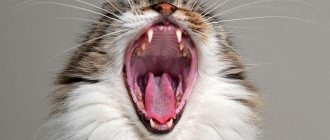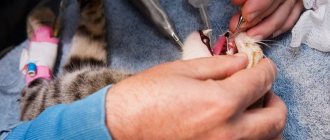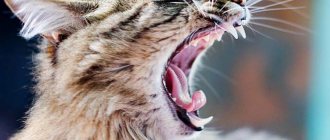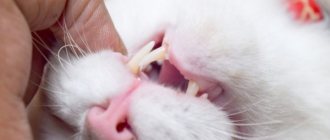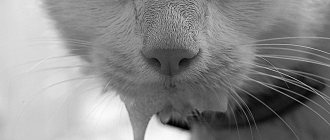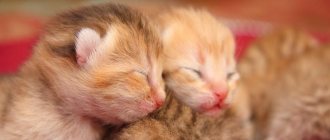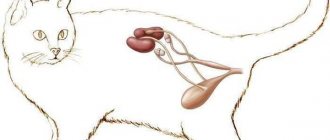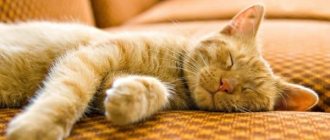For kittens, replacing baby teeth is a natural physiological condition. However, if a cat’s teeth fall out in adulthood, this may be a sign of the development of diseases of internal organs or metabolic disorders in the body. To find out the cause of this pathology, you should contact a veterinarian, who will conduct an examination, prescribe treatment and point out to the cat owner any possible deficiencies in nutrition and care.
Physiological change of teeth in kittens up to one year old
The growth of baby teeth in kittens begins 7-14 days after birth and ends at two months of age. This process goes almost unnoticed by the owners, since the cat takes all care of the offspring.
At 4 months, kittens begin to lose their milk teeth and molars begin to grow. The incisors are the first to change, followed by the lower and upper canines, then the premolars and molars. By seven months, the replacement of 26 baby teeth ends. But before the kitten is one year old, 4 more molars grow, so signs of minor gum inflammation may persist.
Note! Many owners wonder why they shouldn’t vaccinate when their kittens lose their baby teeth. The fact is that the immune system of children is weakened during this period, and the introduction of a complex vaccine can cause clinical signs of the disease.
In most cases, the process is painless, so the owner may not notice that the kitten’s fang or other baby tooth has fallen out. But you should pay attention to the appearance of some signs and show the baby to a veterinarian:
- Refusal to eat for 24 hours. This symptom may be due to severe pain in the gums during teething. Sometimes a kitten, in order to relieve itching, chews on various objects and injures the soft tissues of the oral cavity. During this period, he needs to be given special safe toys, dry food or biscuits.
- The appearance of bad breath. With severe inflammation, ulcers can form on the gums. The cause of the smell is their infection with pathogenic microflora and the development of purulent processes.
- The appearance of molars when the milk teeth have not yet fallen out. If this phenomenon does not bother the kitten, then you should not take drastic measures and interfere with the natural process. However, if gum inflammation occurs, the baby shows severe anxiety, and baby teeth injure the soft tissues of the oral cavity, then surgical intervention is necessary.
To ensure the growth of strong and healthy teeth, you should consult with a veterinarian or an experienced breeder about introducing vitamin and mineral supplements into the diet.
Important! Super premium and holistic foods already contain all the nutritional elements necessary for the growth and formation of strong bones in kittens. Therefore, additional administration of vitamin-mineral complexes will be unnecessary and will lead to the opposite results.
The main causes of tooth loss in adult cats
There are certain reasons why cats lose teeth. These can be injuries, inflammation of the oral cavity, vitamin deficiencies, as well as systemic diseases of the body that lead to serious metabolic disorders.
Teeth loss in cats is a pathology, but their age-related wear is a natural physiological process. The incisors are worn down first, then the molars and premolars. The last thing to lose their enamel is the fangs. Experienced specialists can accurately determine the age of a cat by the number and shape of worn teeth.
Unfortunately, even with proper nutrition and care, no cat is immune from tooth loss. However, owners of representatives of breeds with a shortened muzzle (British, Persians) should pay special attention to the condition of the oral cavity of their pets. These cats are predisposed to early tooth loss due to the specific anatomical structure of the jaw.
Pathologies of the oral cavity
The reasons why cats lose teeth can be diseases of the oral cavity. Experts identify 5 main pathologies.
Gingivitis
This disease is an inflammation of the tissues that surround and hold the dental units within anatomical boundaries, without compromising the integrity of the dentogingival junction. Gingivitis can be localized in the area of 1 tooth, but can affect both jaws. The causes of its occurrence are mechanical, chemical and thermal factors, infectious lesions and systemic diseases of the body. Gingivitis causes gums to become red and painful, making it difficult to chew food. Subsequent softening of the gums leads to cats losing their fangs.
Tartar
A soft plaque forms on a cat's teeth, which gradually hardens and turns into stone. It is dark in color and consists of food debris, dead microorganisms and cells of the oral mucosa and inorganic salts.
Important! Regular removal of soft tartar prevents its mineralization and is an effective prevention of loosening and tooth loss in cats.
Reasons for the formation of tartar:
- poor oral hygiene;
- lack of solid food in the cat’s diet;
- specific metabolic disorders;
- abnormal position of teeth.
The clinical symptoms that appear in the presence of tartar depend on its size and the depth of its penetration under the gum. In cats it is observed:
- profuse salivation;
- the appearance of an unpleasant odor from the oral cavity;
- loosening of teeth;
- difficulty eating.
You can also notice that the cat begins to clack its jaws, as if it wants to get rid of a foreign body.
First, the cat's fangs may fall out, since the stone is formed on them first, and the owner will immediately notice this. This is a serious reason to immediately contact a veterinary clinic to remove tartar.
Caries
Feline caries rarely causes cats to lose teeth, since this pathology is not typical for these animals. However, dietary errors, oral injuries and some metabolic disorders can trigger its development.
At the first stage, the enamel is damaged, and then the destruction process moves to hard tissue.
Symptoms of caries in cats are:
- pain syndrome;
- putrid odor from the mouth;
- profuse drooling;
- the appearance of dark stains on the teeth;
- a sharp decrease in appetite;
- chewing on one side.
Important! In pain, the cat may begin to show aggression. This should be taken into account if there are small children in the house.
Periodontitis
When a veterinarian examines teeth, he pays attention to the condition of the periodontium, since its pathologies are the most common cause of teeth falling out in cats.
At the first stage of periodontal disease, inflammation of the surrounding soft tissue occurs. Gradually, the process involves the bone elements that hold the tooth in the alveolar process of the jaw. If there is no treatment, the cats' teeth will fall out.
The following reasons for the development of periodontal disease are identified:
- the predominance of soft food in the cat’s diet;
- bite deformation;
- lack of oral hygiene.
The most susceptible to periodontal disease are cats whose jaws do not close when chewing.
Injuries
A pet can lose teeth as a result of a blow, fall or accident. In such cases, you should not try to do something yourself. The animal must be quickly taken to a veterinary clinic, where the surgeon, if necessary, will remove the fragments and also examine the condition of other organs and tissues.
Internal illnesses
Internal diseases that most often lead to tooth loss in cats include:
- hypo- and vitamin deficiencies;
- metabolic disorders in the body, which provokes a deficiency of phosphorus, calcium and other vital elements;
- pathologies of the gastrointestinal tract;
- infectious diseases affecting the oral cavity and gastrointestinal tract;
- oncological diseases.
Only an experienced veterinarian can establish a connection between these pathologies and the loss of teeth in cats.
Do cats lose teeth when they get old?
Many owners believe that it is quite normal for a cat to lose teeth due to old age. However, experts do not agree with this statement. Experiments have proven that healthy pets are able to retain all 30 dental units for up to 20 years. Unfortunately, in modern conditions, most pets do not live to an old age, and their average life expectancy ranges from 12 to 17 years. Therefore, when an elderly cat’s teeth fall out, it is not due to old age, but due to maintenance errors and illnesses.
Carrying out the procedure
The tooth extraction procedure is carried out using effective, modern painkillers, so, as a rule, there is no pain during the operation itself.
The operation begins immediately after the anesthesia takes effect. A scalpel is used to loosen the ligament supporting the tooth.
If the procedure was traumatic, or the edges of the wound are too wide, the dental surgeon may use self-absorbing sutures. But most often, the wound is simply closed with a gauze pad with a special hemostatic agent. To stop bleeding, you need to lightly but firmly press the tampon onto the wound with closed jaws. After 20 minutes, the gauze can be spat out.
Associated symptoms
Tooth loss is always accompanied by clinical symptoms that will indicate to owners the presence of problems in the oral cavity. These include:
- unpleasant odor from the mouth;
- increased salivation;
- soreness, redness, possible bleeding of the gums;
- loss of appetite or complete refusal to eat;
- presence of loose teeth.
If it is not possible to immediately go to the clinic, then you should rinse the cat’s mouth with a decoction of chamomile, calendula or oak bark.
Important! It is forbidden to use antibiotics for treatment or try to remove a tooth that is loose on your own.
Gum healing process
The speed of gum healing depends on several factors:
- individual characteristics of the patient’s immunity;
- the success of the operation;
- location of the extracted tooth.
If the tooth is in a hard-to-reach place, has crooked roots, or its crown has been significantly damaged, then the removal procedure becomes more complicated. During manipulation, the tooth may begin to crumble, leaving fragments in the gum. In this case, it is necessary to cut the gum tissue, detach it from the bone, remove the tooth in parts, and use a drill. These traumatic procedures prolong the period of gum healing after surgery.
Slight swelling of the gums is considered normal. The temperature may rise slightly (due to an immune reaction). The swelling usually subsides within three days.
Noticeable swelling of the gum is also observed after cutting it. This swelling goes away in about one week.
Diagnosis and treatment
A veterinarian can decide what to do if a cat's tooth falls out only after making an accurate diagnosis. To do this, he does:
- collection of anamnestic data;
- examination of the oral cavity;
- fluoroscopy.
If the presence of internal pathologies is established, the doctor may prescribe laboratory blood tests and ultrasound of internal organs. Then treatment is prescribed depending on the disease and the presence of accompanying symptoms:
- removal of tartar (if necessary);
- elimination of inflammation of the soft tissues of the oral cavity;
- filling or removal;
- correction of diet;
- elimination of systemic disease (if present).
A veterinarian may prescribe a special diet or introduce vitamin and mineral complexes into the diet.
Preventing tooth loss at home
Prevention of tooth loss in cats includes the following rules:
- monthly brushing of teeth at home using a special toothbrush and paste;
- providing adequate nutrition with sufficient amounts of proteins, vitamins and minerals;
- regular examination of the cat by a veterinarian;
- minimizing the risk of injury;
- timely prevention and treatment of systemic and infectious diseases;
- introduction of solid foods into the diet, which help eliminate plaque.
For any manifestations of oral disease in a cat, the owner should contact a veterinary clinic as soon as possible to determine the cause of the pathology. In the future, you should follow the doctor’s recommendations and examine your pet once every six months. Many people mistakenly believe that tooth loss in cats occurs as a result of aging. In fact, in healthy animals, the chewing apparatus can last up to 20 years. And responsibility for this lies only with the cat owner.
